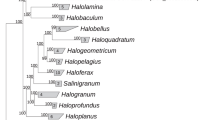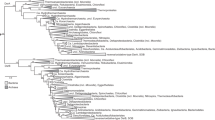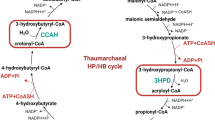Abstract
Extremophilic organisms require specialized enzymes for their exotic metabolisms. Acid-loving thermophilic Archaea that live in the mudpots of volcanic solfataras obtain their energy from reduced sulphur compounds such as hydrogen sulphide (H2S) and carbon disulphide (CS2)1,2. The oxidation of these compounds into sulphuric acid creates the extremely acidic environment that characterizes solfataras. The hyperthermophilic Acidianus strain A1-3, which was isolated from the fumarolic, ancient sauna building at the Solfatara volcano (Naples, Italy), was shown to rapidly convert CS2 into H2S and carbon dioxide (CO2), but nothing has been known about the modes of action and the evolution of the enzyme(s) involved. Here we describe the structure, the proposed mechanism and evolution of a CS2 hydrolase from Acidianus A1-3. The enzyme monomer displays a typical β-carbonic anhydrase fold and active site, yet CO2 is not one of its substrates. Owing to large carboxy- and amino-terminal arms, an unusual hexadecameric catenane oligomer has evolved. This structure results in the blocking of the entrance to the active site that is found in canonical β-carbonic anhydrases and the formation of a single 15-Å-long, highly hydrophobic tunnel that functions as a specificity filter. The tunnel determines the enzyme’s substrate specificity for CS2, which is hydrophobic. The transposon sequences that surround the gene encoding this CS2 hydrolase point to horizontal gene transfer as a mechanism for its acquisition during evolution. Our results show how the ancient β-carbonic anhydrase, which is central to global carbon metabolism, was transformed by divergent evolution into a crucial enzyme in CS2 metabolism.
This is a preview of subscription content, access via your institution
Access options
Subscribe to this journal
Receive 51 print issues and online access
$199.00 per year
only $3.90 per issue
Buy this article
- Purchase on Springer Link
- Instant access to full article PDF
Prices may be subject to local taxes which are calculated during checkout




Similar content being viewed by others
Accession codes
Primary accessions
GenBank/EMBL/DDBJ
Protein Data Bank
Data deposits
The sequence for the CS2 hydrolase from Acidianus A1-3 has been deposited in GenBank under the accession number HM805096. Atomic coordinates and structure factor amplitudes have been deposited in the Protein Data Bank under accession numbers 3TEO and 3TEN.
References
Allard, P., Maiorani, A., Tedesco, D., Cortecci, G. & Turi, B. Isotopic study of the origin of sulfur and carbon in solfatara fumaroles, Campi Flegrei Caldera. J. Volcanol. Geotherm. Res. 48, 139–159 (1991)
Vasilakos, C., Maggos, T., Bartzis, J. G. & Papagiannakopoulos, P. Determination of atmospheric sulfur compounds near a volcanic area in Greece. J. Atmos. Chem. 52, 101–116 (2005)
Reno, M. L., Held, N. L., Fields, C. J., Burke, P. V. & Whitaker, R. J. Biogeography of the Sulfolobus islandicus pan-genome. Proc. Natl Acad. Sci. USA 106, 8605–8610 (2009)
Fuchs, T., Huber, H., Burggraf, S. & Stetter, K. O. 16S rDNA-based phylogeny of the archaeal order Sulfolobales and reclassification of Desulfurolobus ambivalens as Acidianus ambivalens comb nov. Syst. Appl. Microbiol. 19, 56–60 (1996)
He, Z., Li, Y., Zhou, P. & Liu, S.-J. Cloning and heterologous expression of a sulfur oxygenase/reductase gene from the thermoacidophilic archaeon Acidianus sp. S5 in Escherichia coli . FEMS Microbiol. Lett. 193, 217–221 (2000)
Pol, A., van der Drift, C. & Op den Camp, H. J. M. Isolation of a carbon disulfide utilizing Thiomonas sp and its application in a biotrickling filter. Appl. Microbiol. Biotechnol. 74, 439–446 (2007)
Jordan, S. L. et al. Autotrophic growth on carbon disulfide is a property of novel strains of Paracoccus denitrificans . Arch. Microbiol. 168, 225–236 (1997)
Sinnecker, S., Brauer, M., Koch, W. & Anders, E. CS2 fixation by carbonic anhydrase model systems—a new substrate in the catalytic cycle. Inorg. Chem. 40, 1006–1013 (2001)
Notni, J., Schenk, S., Protoschill-Krebs, G., Kesselmeier, J. & Anders, E. The missing link in COS metabolism: a model study on the reactivation of carbonic anhydrase from its hydrosulfide analogue. ChemBioChem 8, 530–536 (2007)
Schenk, S., Kesselmeier, J. & Anders, E. How does the exchange of one oxygen atom with sulfur affect the catalytic cycle of carbonic anhydrase? Chem. Eur. J. 10, 3091–3105 (2004)
Protoschill-Krebs, G., Wilhelm, C. & Kesselmeier, J. Consumption of carbonyl sulphide (COS) by higher plant carbonic anhydrase (CA). Atmos. Environ. 30, 3151–3156 (1996)
Blezinger, S., Wilhelm, C. & Kesselmeier, J. Enzymatic consumption of carbonyl sulfide (COS) by marine algae. Biogeochemistry 48, 185–197 (2000)
Chin, M. & Davis, D. D. Global sources and sinks of OCS and CS2 and their distributions. Glob. Biogeochem. Cycles 7, 321–337 (1993)
Haritos, V. S. & Dojchinov, G. Carbonic anhydrase metabolism is a key factor in the toxicity of CO2 and COS but not CS2 toward the flour beetle Tribolium castaneum [Coleoptera: Tenebrionidae]. Comp. Biochem. Physiol. C Toxicol. Pharmacol. 140, 139–147 (2005)
Smith, K. S. & Ferry, J. G. A plant-type (β-class) carbonic anhydrase in the thermophilic methanoarchaeon Methanobacterium thermoautotrophicum . J. Bacteriol. 181, 6247–6253 (1999)
Alber, B. E. et al. Kinetic and spectroscopic characterization of the γ-carbonic anhydrase from the methanoarchaeon Methanosarcina thermophila . Biochemistry 38, 13119–13128 (1999)
Khalifah, R. G. The carbon dioxide hydration activity of carbonic anhydrase. J. Biol. Chem. 246, 2561–2573 (1971)
Lane, T. W. et al. A cadmium enzyme from a marine diatom. Nature 435, 42 (2005)
MacAuley, S. R. et al. The archetype γ-class carbonic anhydrase (Cam) contains iron when synthesized in vivo . Biochemistry 48, 817–819 (2009)
Kimber, M. S. & Pai, E. F. The active site architecture of Pisum sativum β-carbonic anhydrase is a mirror image of that of α-carbonic anhydrases. EMBO J. 19, 1407–1418 (2000)
Cao, Z., Roszak, A. W., Gourlay, L. J., Lindsay, J. G. & Isaacs, N. W. Bovine mitochondrial peroxiredoxin III forms a two-ring catenane. Structure 13, 1661–1664 (2005)
Wikoff, W. R. et al. Topologically linked protein rings in the bacteriophage HK97 capsid. Science 289, 2129–2133 (2000)
Strop, P., Smith, K. S., Iverson, T. M., Ferry, J. G. & Rees, D. C. Crystal structure of the “cab”-type β class carbonic anhydrase from the archaeon Methanobacterium thermoautotrophicum . J. Biol. Chem. 276, 10299–10305 (2001)
Suarez Covarrubias, A. et al. Structure and function of carbonic anhydrases from Mycobacterium tuberculosis . J. Biol. Chem. 280, 18782–18789 (2005)
Teng, Y. B. et al. Structural insights into the substrate tunnel of Saccharomyces cerevisiae carbonic anhydrase Nce103. BMC Struct. Biol. 9, 67–76 (2009)
Schlicker, C. et al. Structure and inhibition of the CO2-sensing carbonic anhydrase Can2 from the pathogenic fungus Cryptococcus neoformans . J. Mol. Biol. 385, 1207–1220 (2009)
Holm, L., Kaarlainen, S., Rosenstrom, P. & Schenkel, A. Searching protein structure databases with DaliLite v.3. Bioinformatics 25, 2780–2781 (2008)
Rowlett, R. S. Structure and catalytic mechanism of the β-carbonic anhydrases. Biochim. Biophys. Acta 1804, 362–373 (2010)
Smith, K. S., Jakubzick, C., Whittam, T. S. & Ferry, J. G. Carbonic anhydrase is an ancient enzyme widespread in prokaryotes. Proc. Natl Acad. Sci. USA 96, 15184–15189 (1999)
Bornberg-Bauer, E., Huylmans, A.-K. & Sikosek, T. How do new proteins arise? Curr. Opin. Struct. Biol. 20, 390–396 (2010)
Allen, M. B. Studies with Cyanidium caldarium, an anomalously pigmented chlorophyte. Arch. Mikrobiol. 32, 270–277 (1959)
Vishniac, W. & Santer, M. Thiobacilli. Bacteriol. Rev. 21, 195–213 (1957)
Derikx, P. J. L., Op den Camp, H. J. M., van der Drift, C., Van Griensven, L. J. L. D. & Vogels, G. D. Odorous sulphur-compounds emitted during production of compost used as a substrate in mushroom cultivation. Appl. Environ. Microbiol. 56, 176–180 (1990)
Wessels, H. J., Gloerich, J., van der Biezen, E., Jetten, M. S. M. & Kartal, B. Liquid chromatography–mass spectrometry-based proteomics of Nitrosomonas . Methods Enzymol. 486, 465–482 (2011)
Kowalchuk, G. A., de Bruijn, F. J., Head, I. M., Akkermans, A. D., van Elsas, J. D., eds. Molecular Microbial Ecology Manual 2nd edn, Vol. 1 (Kluwer Academic, 2004)
Tamura, K., Dudley, J., Nei, M. & Kumar, S. MEGA4: molecular evolutionary genetics analysis (MEGA) software version 4.0. Mol. Biol. Evol. 24, 1596–1599 (2007)
Saitou, N. & Nei, M. The neighbor-joining method: a new method for reconstructing phylogenetic trees. Mol. Biol. Evol. 4, 406–425 (1987)
Felsenstein, J. Confidence imits on phylogenies: an approach using the bootstrap. Evolution 39, 783–791 (1985)
Zuckerkandl, E. & Pauling, L. Molecules as documents of evolutionary history. J. Theor. Biol. 8, 357–366 (1965)
Kabsch, W. Automatic processing of rotation diffraction data from crystals of initially unknown symmetry and cell constants. J. Appl. Cryst. 26, 795–800 (1993)
Schneider, T. R. & Sheldrick, G. M. Substructure solution with SHELXD. Acta Crystallogr. D 58, 1772–1779 (2002)
Vonrhein, C., Blanc, E., Roversi, P. & Bricogne, G. Automated structure solution with autoSHARP. Methods Mol. Biol. 364, 215–230 (2007)
Emsley, P. & Cowtan, K. Coot: model-building tools for molecular graphics. Acta Crystallogr. D 60, 2126–2132 (2004)
Brünger, A. T. et al. Crystallography and NMR system (CNS): a new software system for macromolecular structure determination. Acta Crystallogr. D 54, 905–921 (1998)
Murshudov, G. N., Vagin, A. A. & Dodson, E. J. Refinement of macromolecular structures by the maximum-likelihood method. Acta Crystallogr. D 53, 240–255 (1997)
McCoy, A., Grosse-Kunstleve, R. W., Storoni, L. C. & Read, R. J. Likelihood-enhanced fast translation functions. Acta Crystallogr. D 61, 458–464 (2005)
Krissinel, E. & Henrick, K. Inference of macromolecular assemblies from crystalline state. J. Mol. Biol. 372, 774–797 (2007)
Schuck, P. Size distribution analysis of macromolecules by sedimentation velocity ultracentrifugation and Lamm equation modeling. Biophys. J. 78, 1606–1619 (2000)
García de la Torre, J., Huertas, M. L. & Carrasco, B. Calculation of hydrodynamic properties of globular proteins from their atomic-level structure. Biophys. J. 78, 719–730 (2000)
Svergun, D. I., Barberato, C. & Koch, M. CRYSOL – a program to evaluate X-ray solution scattering of biological macromolecules from atomic coordinates. J. Appl. Crystallogr. 28, 768–773 (1995)
Konarev, P. V., Volkov, V. V., Sokolova, A. V., Koch, M. & Svergun, D. I. PRIMUS: a Windows PC-based system for small-angle scattering data analysis. J. Appl. Crystallogr. 36, 1277–1282 (2003)
Acknowledgements
J. Eygensteyn is acknowledged for ICP-MS analysis. We thank H. Harhangi for advice on cloning, S. Zimmermann for assistance with cloning, A. Meinhart for discussions and support for cloning and crystallography, and D. Ringe and J. Reinstein for discussions. We thank the Dortmund-Heidelberg data collection team, especially W. Blankenfeldt, and the staff of beam lines X10SA and X12SA at the Swiss Light Source of the PSI in Villigen for their help and facilities. We also thank A. Rufer for help with the analytical ultracentrifuge and I. Vetter for support with the crystallographic software. The work was funded by an STW grant (STW_6353) to M.J.S. and M.H.Z. and by the Max-Planck Society.
Author information
Authors and Affiliations
Contributions
The research was conceived by A.P., M.S.M.J. and H.J.M.O. M.H.Z. performed the sampling, enrichment and isolation. M.J.S., M.H.Z. and A.P. performed the physiological experiments. M.J.S., J.H., A.F.K., L.P.V. and H.J.C.T.W. performed the purification and protein and gene sequencing. A.F.K. and H.J.M.O. performed the MALDI-TOF MS. H.J.M.O. and M.J.S. performed the alignments and phylogenetic analyses. M.J.S. and L.R. performed the site-directed mutant studies, including the activity measurements. A.S. and T.R.M.B. grew the crystals; T.R.M.B. determined the crystal structures and suggested the amino acid residues to be mutated; I.S., A.U. and A.M. performed the SAXS experiments and analyses; and R.L.S. performed the analytical ultracentrifugation experiments. M.J.S., T.R.M.B., I.S., M.S.M.J. and H.J.M.O. wrote the manuscript. All authors discussed the results and commented on the manuscript.
Corresponding author
Ethics declarations
Competing interests
The authors declare no competing financial interests.
Supplementary information
Supplementary Information
This file contains Supplementary Tables 1-3, a Supplementary Legend for Figure 1 and Supplementary Figures 1-9 with legends. (PDF 3457 kb)
Rights and permissions
About this article
Cite this article
Smeulders, M., Barends, T., Pol, A. et al. Evolution of a new enzyme for carbon disulphide conversion by an acidothermophilic archaeon. Nature 478, 412–416 (2011). https://doi.org/10.1038/nature10464
Received:
Accepted:
Published:
Issue Date:
DOI: https://doi.org/10.1038/nature10464
This article is cited by
-
Asp305Gly mutation improved the activity and stability of the styrene monooxygenase for efficient epoxide production in Pseudomonas putida KT2440
Microbial Cell Factories (2019)
-
Cooperative adsorption of carbon disulfide in diamine-appended metal–organic frameworks
Nature Communications (2018)
-
Hydrolytic cleavage of both CS2 carbon–sulfur bonds by multinuclear Pd(II) complexes at room temperature
Nature Chemistry (2017)
-
Shifts of archaeal community structure in soil along an elevation gradient in a reservoir water level fluctuation zone
Journal of Soils and Sediments (2016)
Comments
By submitting a comment you agree to abide by our Terms and Community Guidelines. If you find something abusive or that does not comply with our terms or guidelines please flag it as inappropriate.



